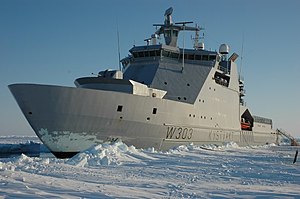NoCGV Svalbard

| |
| History | |
|---|---|
| Name | Svalbard |
| Builder | Hull at Tangen Verft, Kragerø Outhfitting at Langsten Tomrefjord |
| Cost | NOK 575 million (US$80 million)[Note 1] |
| Laid down | 9 August 2000 |
| Launched | 17 February 2001 |
| Commissioned | 15 December 2001 |
| Identification |
|
| Status | In service |
| General characteristics | |
| Class and type | Offshore patrol vessel |
| Displacement | 6,375 tonnes |
| Length |
|
| Beam | 62.6 ft (19.1 m) |
| Height | 27.2 ft (8.3 m) |
| Draught | 21.3 ft (6.5 m) |
| Installed power | Four Rolls-Royce Bergen BRG-8 diesel generators (4 × 3,390 kW) |
| Propulsion |
|
| Speed | 17.5 knots (32.4 km/h; 20.1 mph) |
| Complement | 50 (20 Officers and 45 Other Ranks split into 3 shifts with 2 shifts on board at any one time) |
| Sensors and processing systems | EADS TRS-3D /16 ES with IFF |
| Armament |
|
| Aircraft carried | Capacity for two helicopters; one Lynx carried initially, NH90 from 2009 |
The Norwegian Coast Guard icebreaker and offshore patrol vessel NoCGV Svalbard (W303) was constructed by Langsten AS at Tangen Verft shipyard in Kragerø and launched on 17 February 2001. She was named 15 December in Tomrefjord with Minister of Defence Kristin Krohn Devold as godmother, and delivered to the Coast Guard on 18 January 2002. She entered service in mid-2002 and is homeported in Sortland. Her primary operating area is in the Arctic waters north of Norway, the Barents Sea and around the Svalbard islands. On 21 August 2019, Svalbard became the first Norwegian ship to reach the North Pole.[3]
Svalbard is the second largest ship in Norway's military armed forces (by tonnage), designed to supplement the three other helicopter-carrying ships of the Norwegian Coast Guard - the Template:Sclass-s. She is NBC-protected with constant overpressure, and is capable of icebreaking and emergency towing up to 100,000 tons. The Norwegian coastline is generally free of ice, thus Svalbard is the only active Norwegian icebreaking-capable vessel. A double acting ship, Svalbard is designed to break ice both ahead and astern.
Foreign analogs
On 9 July 2007 the Canadian Broadcasting Corporation reported that Canadian Prime Minister Stephen Harper had announced that Canada would be building six to eight arctic offshore patrol ships (AOPS) for the Royal Canadian Navy, modeled after Svalbard's design.[4][5] However, due to cost constraints the design was changed to a more conventional twin-shaft arrangement and as of 2015[update] the number of ships has been reduced to five with an option for six if it comes under the CAD$3.5 billion budget.[6] The project has been criticized for its inexplicable high costs. For example, Irving Shipbuilding was awarded a CAD$288 million design contract for the vessel while the design of Svalbard and similar patrol ships within other countries paid less than one-tenth as much. In addition, other similar vessels were built for about one third of the value of the Canadian AOPS's construction contract.[7]
In 2015 Russia started constructing the first of several vessels in its Project 23550.[8] Think tank Global Security pointed out these vessels are almost the same length, displacement, power and endurance as the Svalbard class. They will also be able to travel through roughly the same depth of ice. The Russian vessels will be more heavily armed, with a 76 or 100 mm main cannon, an anti-missile gatling gun, and launchers for eight cruise missiles.
Notes
- ^ Radar and helicopter not included.
- ^ References - Propulsion Products. ABB. Retrieved 2015-05-28.
- ^ Wertheim, Eric. The Naval Institute Guide to Combat Fleets of the World, 15th edition. Naval Institute Press. p. 520. ISBN 978-1-59114-955-2.
- ^ "Norwegian Coast Guard vessel reaches North Pole". The Independent Barents Observer. 21 August 2019. Retrieved 21 August 2019.
- ^ "Ottawa buying up to 8 Arctic patrol ships". CBC. 9 July 2007. Retrieved 2007-07-10.
- ^ "Arctic patrol vessels approved by committee". CBC. 13 May 2007. Retrieved 2007-07-10.
- ^ Cudmore, James (16 January 2015). "Canada's navy to get 5 or 6 Arctic ships, not 8". CBC News. Retrieved 17 January 2015.
- ^ Milewski, Terry (2 May 2013). "Shipbuilding contract holds $250M mystery". CBC News. Retrieved 17 January 2015.
- ^ "Project 23550 Ivan Papanin - patrol icebreaker". Global Security.
External links
- Marinelog article
- Marinetalk article: KV Svalbard
- Norwegian Forsvaerets article: KV Svalbard
- Martin Shadwick (Spring 2007). "Due North" (PDF). Vol. 8, no. 1. Canadian Military Journal. Archived from the original (PDF) on 2008-04-10. Retrieved 2008-02-19.
